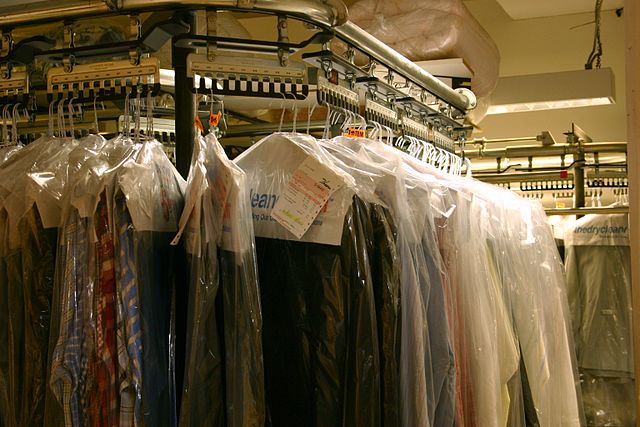
How does dry cleaning work? Clothes are soaked in a water-free liquid solvent.
Dry cleaning is a way of washing clothes without water. At home, all of us wash our clothes in the washing machine using some kind of detergent and water. Inside the washing machine is something called an agitator. This is a drum with ridges. You fill the washing machine with water, add detergent, and the agitator starts to move the clothes backwards and forwards. This has several purposes. It moves the clothes around so that the detergent can reach all parts of them. It creates friction, which the detergent needs to remove dirt. It allows all of the clothes to be washed equally.
Laundry detergent contains something called surfactants. These are surface-active agents and they are able to interact with both oil and water. Some molecules are hydrophobic (not attracted to water) and some molecules are hydrophilic (attracted to water). Surfactants have a hydrophobic end which is repelled by water, but attracted by oil, and a hydrophilic end that is attracted to water. That means, when you add detergent and water to your washing machine full of clothes, the surfactants are able to attach themselves to the grease and to the water. This won’t remove the dirt without the friction that we talked about earlier. When the agitator moves, it pushes the clothes back and forth and the force of the water pulls the grease out of the clothes.
Washing in water is very effective, but some materials don’t do well with water. Wool absorbs a lot of water and the fibers can stretch or shrink if the wool is moved while washing. There are also some stains that detergent and water are not able to pull out. As well as this, people wash their clothes often and washing machines can wear them out. This is why people use dry cleaning.
Dry cleaners use solvents to remove the oils and dirt from the clothes without using water. The solvent they use is called perchloroethylene (shortened to perc), although it is currently being phased out because it can pose a serious health risk to the dry cleaners.
How does the solvent perc remove dirt? A solvent is a substance that can dissolve another substance. Water is a solvent, but water is not able to dissolve grease and most dirt. Perchloroethylene has lipophilic properties, which means that its molecules are attracted to fat and oil. When they attach to the fat molecules, they can pull it away, dissolving it.
When clothes are washed at a dry cleaners, they are loaded into a washing machine that is fed from a tank of perc. The machine is filled to about 60% with the solvent and it starts to rotate, in the same way as a regular machine. Unlike with a regular washing machine, the solvent is not kept in the drum, instead it constantly runs through. It goes into the drum, attaches itself to fats, comes out of the drum, goes through a filter, and goes back into the drum. Once the washing cycle has finished, the clothes are washed with fresh solvent and then they are spun to remove as much solvent as possible. Finally, they are dried in warm air to evaporate the rest of the solvent. So, a dry cleaning machine is basically the same as a regular washing machine, except it uses perchloroethylene instead of water.
Dry cleaning has existed for thousands of years. Most people washed their clothes in rivers but the Romans used ammonia to clean woolen togas. Thomas L. Jennings is credited with being the first dry cleaner. He received a patent in 1821 for a method of dry cleaning. He started off as a tailor, but realized his method for cleaning clothes could be profitable. He called it dry scouring and he washed the clothes in a mix of solvents that could dissolve fats. He received the patent and opened up the first dry cleaners. It made him a wealthy man, but he was an African-American at a time when racial segregation and slavery still existed. He pumped most of his profits into the abolition movement.
Perchloroethylene is a great solvent, but it has been called a carcinogenic substance. It is a central nervous system suppressant and can enter the body by being inhaled or through the skin. Because of this, other solvents are being created for dry cleaning. None of them are as yet as good as perc, though.
So, dry cleaning involves washing clothes in a solvent that can dissolve fat. And this is what I learned today.
Sources
https://en.wikipedia.org/wiki/Dry_cleaning
https://www.thespruce.com/what-is-dry-cleaning-2145885
https://www.thespruce.com/why-clothes-shrink-in-the-laundry-2146152
https://home.howstuffworks.com/how-do-washing-machines-get-clothes-clean2.htm
https://home.howstuffworks.com/laundry-detergent.htm
